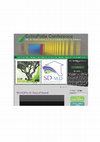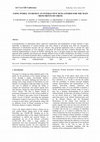Papers by Panos Parthenios
Proceedings of the 39th International Conference on Education and Research in Computer Aided Architectural Design in Europe (eCAADe)

Proceedings of the 36th International Conference on Education and Research in Computer Aided Architectural Design in Europe (eCAADe) [Volume 2]
With a view to design-led digital applications that meet the material world, we create hybrid spa... more With a view to design-led digital applications that meet the material world, we create hybrid spaces, where the user/visitor is active and takes part in one action in the material and virtual world. So, today, museums all over the world face the opportunity to re-invent themselves and their relationships with their visitors. They establish a complex non-linear dynamic ecosystem. Τhis transformation brings out series of queries, such as the role of the architect that redefines the museum process and the new terms in the museum context. This paper refers to the dynamic changes that define a hybrid environment, describes the transformation into a user-centric museum and the approach to create visitor/user-centered museum and how this was applied into the Archaeological Museum in Chania, Crete. A museum that places visitors at the center of its mission.

Nowadays, over 60% of the world population live within a 40 miles wide area along the coastline. ... more Nowadays, over 60% of the world population live within a 40 miles wide area along the coastline. Additionally, coastal areas are among the best tourist attractions and economic activity hubs. According to the United Nations World Tourism Organization, the number of international tourist arrivals worldwide is expected to increase by an average of 3,3% a year over the period 2010 to 2030. In absolute numbers, international tourist arrivals worldwide are expected to reach 1,4 billion by 2020 and 1,8 billion by 2030. The combined effects of urbanization in coastal areas, global climate warming and the continuous increase of human flow can give rise on a decrease of the air and water quality as well as an increase in aesthetic and noise pollution and humidity levels [1]. While human presence has a significant impact on the urban environment, the urban conditions radically affect the intensity of tourism flow, as it is one of the main interests on the seaside. Traditionally, urban plannin...

Smart Cities and the un SDGs, 2021
Abstract Recent debates on how contemporary cities can face global challenges highlight the conce... more Abstract Recent debates on how contemporary cities can face global challenges highlight the conceptual obscurity of smart city strategies. This is particularly true in the context of the imperatives outlined in the UN’s Sustainable Development Goals (SDGs) including the objective to improve citizens’ well-being. In fact, the achievement of well-being is increasingly part of smart city projects worldwide in a fragmented way, and this chapter aims at clarifying it by examining the impact of such an approach to spatial planning. Through research in three different European cities (Barcelona, Copenhagen, and Vienna), the authors point out the functions and benefits of incorporating urban technologies into public space, the orientation that spatial planning is now taking, and how participatory strategies enhance city well-being. The chapter suggests that in the intersection of smart and sustainable city models emerge the indicators for successful urban strategies, and reveals a number of valuable observations that promote the achievement of city well-being.
This paper proposes the use of Structure from Motion (SfM) techniques to survey inaccessible monu... more This paper proposes the use of Structure from Motion (SfM) techniques to survey inaccessible monument structures and presents its application on capturing Kornarou Square's philanthropic fountain in Heraklion, Crete. A series of aerial and terrestrial photos of the fountain were combined in order to build the 3D geometry of the monument using Agistoft's Photoscan. This 3D model was used to study the dynamic behavior of the fountain. Its response was determined through multiple inelastic dynamic analyses. The analysis results were summarized in the average dynamic curve.

Blucher Design Proceedings, 2019
During the last two decades, the introduction of digital multimedia into the museums, monuments a... more During the last two decades, the introduction of digital multimedia into the museums, monuments and exhibition spaces describe a new open and flexible institution, which is attentive to the needs of its visitors. In fact, many different opinions, preferences and personalized agendas acquire now a symbiotic relationship with the strict archeological site contexts with ICT. This relationship is established the moment that the actual space comes into terms with the visitors' needs and without compromising spatially, it reveals all the different movement alternatives that could satisfy the visitor. In fact, ICTs create alternative experiences through the juxtaposition of a digital layer on physical space. Drawing on this objective, this paper studies the relation between user and monument by enhancing their interaction in the Municipal Market of Chania, in Crete. The objective of the paper is to examine how state-of-the-art IoT systems can be seamlessly incorporated into the smart cultural heritage strategy of the suggested place. The macroscope is to explore alternatives strategies to enhance sustainable tourism in Chania.
Electronic Workshops in Computing, 2012

International Journal of Architectural Computing, 2016
The more complex our cities become, the more difficult it is for designers to use traditional too... more The more complex our cities become, the more difficult it is for designers to use traditional tools for understanding and analyzing the inner essence of an eco-system such as the contemporary urban environment. Even many of the recently crafted digital tools fail to address the necessity for a more holistic design approach which captures the virtual and the physical, the immaterial and the material. Handling of massive chunks of information and classification and assessment of diverse data are nowadays more crucial than ever before. We see a significant potential in combining the fields of composition in music and architecture through the use of information technology. Merging the two fields has the intense potential to release new, innovative tools for urban designers. This article describes an innovative tool developed at the Technical University of Crete, through which an urban designer can work on the music transcription of a specific urban environment applying music composition...
2015 Digital Heritage, 2015
The scope of this paper is to highlight the challenges, advantages and disadvantages, as well as ... more The scope of this paper is to highlight the challenges, advantages and disadvantages, as well as solutions to some of the issues that arise during the process of a monument's virtual 3D reconstruction using Structure from Motion (SfM) techniques. Yali Tzamisi, a 17th century monument located in Chania, Crete, has been photographed appropriately by three separate student groups, one for the building's envelope, one for the building's interior space and one for the surroundings of the monument. Different levels of detail and various file formats have been documented according to their scope of use, before the three models were merged into one unified 3D scene.

2015 Digital Heritage, 2015
Various archeological evidence suggest the significance of the ancient city of Gortyn, capital of... more Various archeological evidence suggest the significance of the ancient city of Gortyn, capital of the Roman province of Crete since 67 AD till the end of the supremacy of the Roman Empire, around the VII century. Still a number of monumental buildings, of which archaeological remains are less majestic, have to be well studied and understood. Among others, it is the large Roman theatre built on the South-East slope of the acropolis. The area is currently inspected through archaeological excavations, under the Ephorate of Prehistoric and Classical Antiquities of the Municipality of Herakleion. The visible remains of the theatre are still quite few but information about it is available thanks to many different sources: plans, descriptions and geophysical surveys. A careful analysis of these documents allow us to make various hypotheses about the original structure of the theatre that will be shown through the 3D reconstruction of the monument. With the help of the visualization tool it will be possible to identify which hypothesis represents better the original aspect of the theatre. The aim of this paper is to manifest the way that meaningful results can be drawn through the combination of traditional instruments with new technologies and methods, and to underline the power of visualization for the comprehension of archaeological context.
This paper presents a methodology to augment acoustically the experience of the urban environment... more This paper presents a methodology to augment acoustically the experience of the urban environment by mapping its fundamental spatial elements and translating them to sound and music. The methodology can be applied at any given path of an urban network to generate its acoustical representation with sounds produced by appropriately chosen musical instruments. The objective is twofold. On the one hand it targets the amelioration of the urban experience of people with impaired vision while on the other it offers a more synaesthetic spatial perception to all those who rely mostly on their retinal understanding of the environment.

The more complex our cities become the more difficult it is for designers to use traditional tool... more The more complex our cities become the more difficult it is for designers to use traditional tools for understanding and analyzing the inner essence of an eco-system such as the contemporary urban environment. Even many of the recently crafted digital tools fail to address the necessity for a more holistic design approach which captures the virtual and the physical, the bits and the atoms, the immaterial and the material. The main reason is that they attempt to imitate the functions of traditional tools, without realizing that needs are now different and emerging ecologies have evolved to form a new synthetic spectrum which demands radical digital innovation. Handling of massive chunks of information, classification and assessment of diverse data is nowadays more crucial than ever before. We see a significant potential in combining the fields of composition in music and architecture through the use of information technology. We propose an encoding-decoding mechanism between atoms, b...

One of the fundamental vehicles for stimulating innovation in architectural education is question... more One of the fundamental vehicles for stimulating innovation in architectural education is questioning the predictable and the proved. Concrete fields of architectural design thinking and existing frameworks of tools and means should be redefined with an attempt to formulate the unexpected by overcoming the limitations of each system and creatively merging the competitive advantages of each component. At the School of Architecture in Crete (T.U.C.) during the spring semester of 2010 we took an innovative approach regarding the teaching of different subject areas of architectural curricula, by merging two different classes: “Digital Media in Architectural Design III” and “Environmental Architectural Design”. In particular, the students were asked to design a pavilion, placed on a specific site in the city of Chania, with one basic requirement: to embody and display through its architectural resolution a specific environmental system. As a conceptual tool at the initial stages of the ex...

Conceptualization of information allows improved visualization and manipulation of large amounts ... more Conceptualization of information allows improved visualization and manipulation of large amounts of data. Especially in digitization of cultural heritage and when aiming at presenting more than one monuments, abstraction of information becomes the key solution. Our proposed application aims to present the main archaeological monuments of Crete through a conceptual 3D model and their evolution through time. The technical implementation is based on WebGL allowing the user to navigate among the main monuments and approach them gradually and interactively through different levels of detail. Furthermore, the ability to switch between the seven historical periods offers a comparative study of their evolution in time. Conceptualization and abstraction of information through varied levels of detail allows the application to be available to anyone on the web, being computationally light and easy to use.
International Journal of Heritage in the Digital Era, 2012
Uploads
Papers by Panos Parthenios